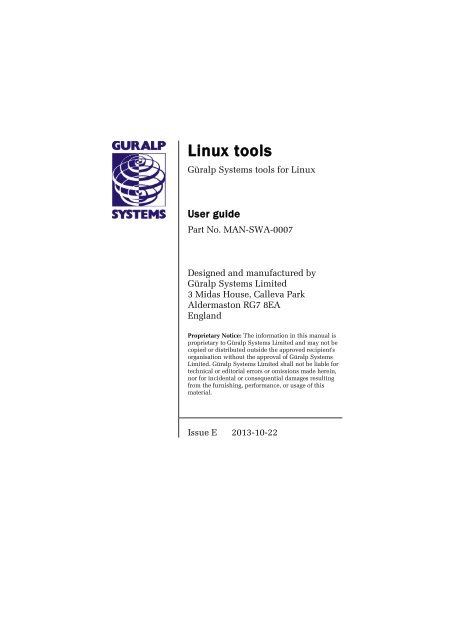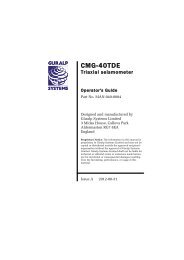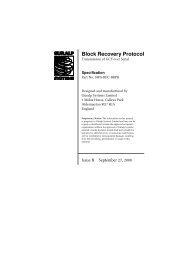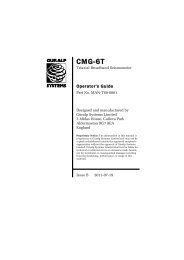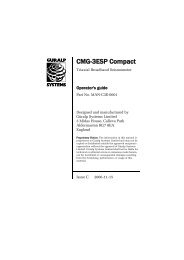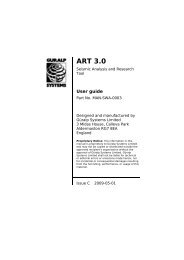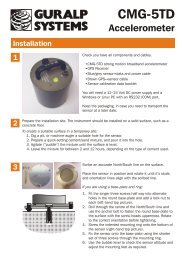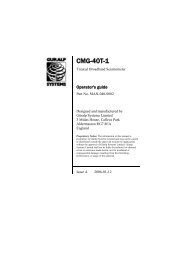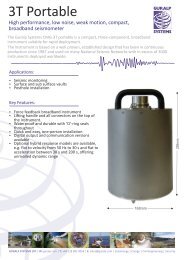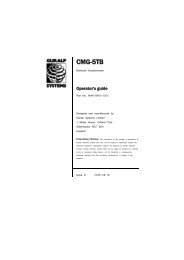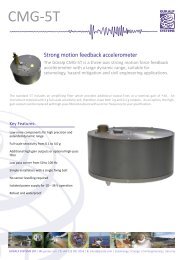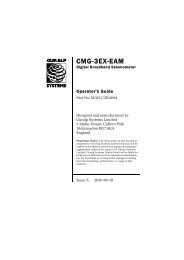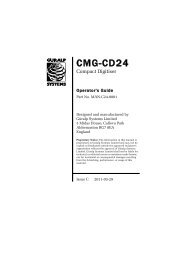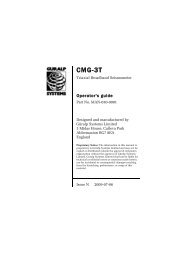linux-tools - Güralp Systems Ltd
linux-tools - Güralp Systems Ltd
linux-tools - Güralp Systems Ltd
Create successful ePaper yourself
Turn your PDF publications into a flip-book with our unique Google optimized e-Paper software.
Linux <strong>tools</strong><br />
<strong>Güralp</strong> <strong>Systems</strong> <strong>tools</strong> for Linux<br />
User guide<br />
Part No. MAN-SWA-0007<br />
Designed and manufactured by<br />
<strong>Güralp</strong> <strong>Systems</strong> Limited<br />
3 Midas House, Calleva Park<br />
Aldermaston RG7 8EA<br />
England<br />
Proprietary Notice: The information in this manual is<br />
proprietary to <strong>Güralp</strong> <strong>Systems</strong> Limited and may not be<br />
copied or distributed outside the approved recipient's<br />
organisation without the approval of <strong>Güralp</strong> <strong>Systems</strong><br />
Limited. <strong>Güralp</strong> <strong>Systems</strong> Limited shall not be liable for<br />
technical or editorial errors or omissions made herein,<br />
nor for incidental or consequential damages resulting<br />
from the furnishing, performance, or usage of this<br />
material.<br />
Issue E 2013-10-22
<strong>Güralp</strong> <strong>Systems</strong> Linux <strong>tools</strong><br />
Table of Contents<br />
1 Introduction...............................................................................................................5<br />
2 Installing the <strong>tools</strong>.....................................................................................................6<br />
2.1 Prerequisites.......................................................................................................6<br />
2.2 Installation instructions.....................................................................................6<br />
2.3 Updating and recompiling packages..................................................................8<br />
2.4 Shared library management...............................................................................8<br />
2.5 Running daemons at start-up.............................................................................9<br />
3 Applications.............................................................................................................10<br />
3.1 data-gcf-dump...................................................................................................10<br />
3.2 read-rawgcfdisk................................................................................................10<br />
3.3 gcf-to-miniseed.................................................................................................11<br />
3.3.1 Conversion process...............................................................................11<br />
3.3.2 Auto-mapping mode..............................................................................12<br />
3.4 tcpserial.............................................................................................................12<br />
3.4.1 Operating modes...................................................................................13<br />
3.5 ntp-to-nmea.......................................................................................................14<br />
3.5.1 Initial testing..........................................................................................14<br />
3.6 cd11-test-recv....................................................................................................15<br />
3.6.1 Running the receiver.............................................................................15<br />
3.6.2 Generating reports.................................................................................17<br />
3.6.3 Clock differential plots..........................................................................18<br />
3.6.4 Latency/timeliness plots........................................................................18<br />
3.7 scream_in [obsolete].........................................................................................18<br />
3.7.1 Required options...................................................................................19<br />
3.7.2 UDP push...............................................................................................19<br />
3.7.3 UDP pull................................................................................................19<br />
3.7.4 TCP pull.................................................................................................20<br />
3.7.5 Additional options.................................................................................20<br />
3.8 slserver [obsolete].............................................................................................20<br />
3.8.1 Required options...................................................................................21<br />
3.8.2 Additional options.................................................................................21<br />
3.9 msrecorder [obsolete].......................................................................................22<br />
3.9.1 Options..................................................................................................22<br />
4 Libraries...................................................................................................................23<br />
4.1 Core libraries.....................................................................................................23<br />
4.1.1 libiso8601..............................................................................................23<br />
2 Issue E
User guide<br />
4.1.2 libcgic.....................................................................................................23<br />
4.1.3 libgslutil.................................................................................................23<br />
4.1.4 libCStreamedXML.................................................................................23<br />
4.1.5 libtimespan............................................................................................23<br />
4.1.6 libframesettrack.....................................................................................24<br />
4.2 Seismic data formats........................................................................................24<br />
4.2.1 libdata-gcf..............................................................................................24<br />
4.2.2 libdata-strong-motion............................................................................24<br />
4.2.3 libdata-unified-status............................................................................24<br />
4.2.4 libmseed.................................................................................................24<br />
4.3 Obsolete libraries..............................................................................................24<br />
4.3.1 libgcf2 [obsolete]...................................................................................25<br />
4.3.2 libminiseed [obsolete]...........................................................................25<br />
4.3.3 libmsrecorder [obsolete]........................................................................25<br />
4.3.4 libplaces [obsolete]................................................................................25<br />
4.3.5 libgobj [obsolete]...................................................................................25<br />
4.3.6 libgdd [obsolete]....................................................................................26<br />
4.3.7 libseedmap2 [obsolete]..........................................................................26<br />
5 Configuration files...................................................................................................27<br />
5.1 gcf-to-miniseed.................................................................................................27<br />
5.1.1 General options.....................................................................................27<br />
5.1.2 Output options......................................................................................27<br />
5.1.3 Channel mapping..................................................................................28<br />
5.1.4 Output file names..................................................................................28<br />
5.2 tcpserial.............................................................................................................29<br />
5.2.1 Simple server mode...............................................................................29<br />
5.2.2 Simple client mode...............................................................................30<br />
5.3 ntp-to-nmea.......................................................................................................30<br />
5.3.1 Logging...................................................................................................30<br />
5.3.2 Serial port configuration.......................................................................31<br />
5.3.3 NMEA sentence configuration..............................................................31<br />
5.3.4 NTP configuration.................................................................................31<br />
5.4 cd11-test-recv....................................................................................................31<br />
5.4.1 Logging...................................................................................................32<br />
5.4.2 Network configuration..........................................................................32<br />
5.4.3 CD1.1 configuration..............................................................................32<br />
5.4.4 Files........................................................................................................33<br />
5.4.5 Sample configuration............................................................................33<br />
5.5 dcmplaces.conf.................................................................................................33<br />
5.6 seedmap2.xml...................................................................................................34<br />
5.6.1 XML elements........................................................................................34<br />
5.6.2 Stream attributes...................................................................................35<br />
5.6.3 seedmap_cmd........................................................................................35<br />
6 Revision history.......................................................................................................37<br />
October 2013 3
<strong>Güralp</strong> <strong>Systems</strong> Linux <strong>tools</strong><br />
1 Introduction<br />
The <strong>Güralp</strong> <strong>Systems</strong> Linux <strong>tools</strong> are a suite of open-source libraries<br />
and applications for handling the recording and transfer of seismic<br />
data.<br />
They are written for a generic Linux system and include a simple<br />
package management system which downloads the source code for<br />
each package and automatically compiles it for your system.<br />
The <strong>tools</strong> have been tested on Ubuntu (12.04), Debian (6 and 7) and<br />
Gentoo distributions of Linux.<br />
4 Issue E
2 Installing the <strong>tools</strong><br />
User guide<br />
The <strong>Güralp</strong> <strong>Systems</strong> Linux <strong>tools</strong> are managed by guralp-builder.<br />
This is a simple framework which can download, build and install all<br />
of the <strong>tools</strong> and the libraries they require. It also keeps track of<br />
dependencies between versions.<br />
guralp-builder can be downloaded from our Web site at<br />
http://www.guralp.com/software/<strong>tools</strong>/guralp-builder/guralp-builder<br />
-20071117.tar.bz2<br />
The scripts require the standard Web downloading utility, wget, to<br />
fetch source code from the <strong>Güralp</strong> <strong>Systems</strong> repository.<br />
2.1 Prerequisites<br />
Your system must be set up for development or compilation (i.e.<br />
development <strong>tools</strong> such as gcc must be installed). The “Bourne again”<br />
shell, bash, is also required.<br />
Several of the programs require other open-source packages. If<br />
compilation fails and complains about a missing file with a name<br />
similar to one of these, try installing the package's development<br />
version through your system's package manager tool:<br />
• libevent (http://www.monkey.org/~provos/libevent/)<br />
• gnutls (http://www.gnu.org/software/gnutls/)<br />
2.2 Installation instructions<br />
To install the <strong>tools</strong>:<br />
1. Create a build directory for the <strong>tools</strong>.<br />
2. Unzip and untar the file into the build directory. Two scripts,<br />
install.sh and update.sh, and a data directory will be<br />
created.<br />
3. Edit the file data/config.example<br />
This file contains a single variable, which sets the path prefix,<br />
PREFIX, for installed files. This can be either a standard system<br />
prefix (/usr or /usr/local), or another location of your<br />
choice.<br />
October 2013 5
<strong>Güralp</strong> <strong>Systems</strong> Linux <strong>tools</strong><br />
Files will be installed in bin/, lib/, and include/ directories<br />
beneath the PREFIX directory.<br />
Save the file as data/config<br />
4. Download the list of available packages by running the script<br />
./update.sh<br />
You will see a new directory, var/, created in the build<br />
directory. This directory is used to store downloaded source<br />
files.<br />
5. Now run the script<br />
./install.sh<br />
Without any arguments, this script prints a list of the packages<br />
you can build. See the later chapters for details of each<br />
package.<br />
6. To build and install a package, run<br />
install.sh packagename<br />
using the package name from the list output in the previous<br />
step.<br />
The installer places archive files in a new directory, ar/, inside<br />
the build directory. These are extracted into var/, and the<br />
source files compiled automatically.<br />
Dependencies will also be compiled.<br />
7. The compiled programs and libraries are installed in the PREFIX<br />
directory. If you are using a system directory (/usr or<br />
/usr/local), run<br />
ldconfig<br />
to tell your system about the new libraries.<br />
If you are using a different PREFIX directory, add the name of<br />
the lib/ directory to the environment variable<br />
LD_LIBRARY_PATH and the name of the bin/ directory to the<br />
environment variable PATH<br />
6 Issue E
User guide<br />
If you are using the bash shell, you can do this with<br />
export LD_LIBRARY_PATH="/path/to/lib:$LD_LIBRARY_PATH"<br />
2.3 Updating and recompiling packages<br />
To update a package, run<br />
update.sh<br />
in the build directory, then install as above. If you already have the<br />
current version, the script will do nothing.<br />
If you need to recompile a package, remove its source directory from<br />
var/ in the build directory, then<br />
install.sh packagename<br />
To completely reinstall all packages, remove the ar/ and var/<br />
directories, then update and install as above.<br />
Users with installations from before 2009-02-16 are advised to follow<br />
the complete reinstallation procedure when updating after this date, as<br />
a binary incompatible change in one of the core libraries requires most<br />
packages to be rebuilt.<br />
2.4 Shared library management<br />
If the <strong>tools</strong> are installed to a standard directory (i.e. /usr or, on some<br />
systems, /usr/local) then the “ldconfig” program must be run as root<br />
after installing or updating shared libraries.<br />
If installed to a custom directory, there are two options. Either add the<br />
library directory (e.g. /opt/guralp/lib) to the<br />
file /etc/ld.so.conf (see the ldconfig(8) manpage for details), or<br />
run a command such as:<br />
ldconfig n /opt/guralp/lib<br />
In any case, the ldconfig utility must be run after installation/update in<br />
order that the programs find the correct shared libraries. ldconfig<br />
manages library symlinks to allow for multiple compatible and<br />
incompatible versions of a library to be installed simultaneously.<br />
Please contact Guralp support if you need further help with this issue<br />
(in particular if you have library or symbol not found errors when<br />
running the <strong>tools</strong>).<br />
October 2013 7
<strong>Güralp</strong> <strong>Systems</strong> Linux <strong>tools</strong><br />
2.5 Running daemons at start-up<br />
Several of these packages are intended to be run as daemons; processes<br />
which run in the background and are independent of any users on the<br />
system. It is recommended that a package such as daemon-<strong>tools</strong>,<br />
start-stop-daemon or daemonitor is used for this purpose. (The<br />
daemonitor package can be downloaded from<br />
http://www.lwithers.me.uk/usr/src/daemonitor/.)<br />
Integration with the operating system differs by distribution, and is<br />
beyond the scope of this document. Generally the distribution's “init<br />
scripts” are used to perform this.<br />
8 Issue E
3 Applications<br />
3.1 data-gcf-dump<br />
User guide<br />
This tool is provided as part of the libdata-gcf library. Its purpose is to<br />
display a summary (or optionally the details) of a particular GCF file.<br />
The input file can be any file (or device) in which GCF blocks are<br />
written sequentially at 1024 byte boundaries.<br />
Usage:<br />
datagcfdump [d] file1.gcf [file2.gcf ...]<br />
Without the -d flag, a single line summary is printed for each block<br />
that could be decoded from the file. With the -d flag, the block is also<br />
decoded; raw sample values are displayed in ASCII and the contents of<br />
status, unified status and strong motion blocks are printed.<br />
3.2 read-rawgcfdisk<br />
This tool displays the directory structure of a DFD (6TD/DM24 with<br />
IEEE1394 option) disk or a SAM disk.<br />
Attach the disk to the system and find its device node, e.g. /dev/sdc<br />
(note: if the disk happens to have a valid partition table, you must<br />
ensure you use the raw block device as shown and not a partition<br />
like /dev/sdc1).<br />
The disk directory may be displayed with the command:<br />
readrawgcfdisk /dev/sdc [/dev/sdd ...]<br />
As shown, it is possible to display multiple directories with a single<br />
invocation.<br />
It is also possible to use the tool on an image of a disk. To recover the<br />
directory information, only the first 9kiB (18 sectors) are required.<br />
However, this will cause the serial number, start time and end time to<br />
be omitted from the display unless they are included in the file.<br />
When displaying a DFD disk in which one of the transfers contains<br />
some empty blocks at the start of the lump, an exclamation mark “!”<br />
will be displayed before the start time. This is not indicative of a<br />
problem with the data.<br />
October 2013 9
<strong>Güralp</strong> <strong>Systems</strong> Linux <strong>tools</strong><br />
3.3 gcf-to-miniseed<br />
This is an offline data conversion tool which takes files of raw<br />
1024-byte GCF blocks as input and writes out data only SEED volumes<br />
(Mini-SEED records).<br />
A configuration file is used to specify parameters for the conversion<br />
and optionally to map GCF channel names onto SEED names. The<br />
configuration file is covered in detail in section 5.1 on page 26. A<br />
template configuration file may be created using the config template<br />
option (may be shortened to T):<br />
gcftominiseed configtemplate<br />
The tool has two main modes of operation: auto-mapping mode, in<br />
which all usable data is extracted and SEED names are generated<br />
automatically, and manual mapped mode, in which the mappings<br />
must be specified in the configuration file and data from unknown<br />
channels is ignored.<br />
To invoke the tool, use:<br />
gcftominiseed [a] c config.cf input1.gcf [input2.gcf ...]<br />
The a or automap option, if present, activates auto-mapping<br />
mode. The c or config option specifies the path to the<br />
configuration file. The remaining arguments are the GCF files to<br />
convert.<br />
3.3.1 Conversion process<br />
The tool takes an arbitrary number of GCF files as inputs. The<br />
contents and order of the GCF files are irrelevant; the tool maps each<br />
file into memory, decodes all of the block headers, and then sorts the<br />
headers by channel and date. It then extracts the data using the order<br />
specified by the sorted headers, possibly interleaving reads across<br />
multiple input files.<br />
The GCF files must consist of a set of GCF blocks residing at 1024 byte<br />
boundaries. The full specification of GCF (Guralp compressed format)<br />
can be downloaded from our website at<br />
http://www.guralp.com/guralp-compressed-format-gcf-specifications/.<br />
Output file naming (and the length of Mini-SEED files to output) is<br />
handled in the configuration file. It is possible to combine Mini-SEED<br />
records from different channels in the same file. Each output file may<br />
10 Issue E
User guide<br />
be split into time segments of 10 seconds to 1 day. GCF blocks which<br />
straddle time boundaries are split across two output files.<br />
The behaviour when an invalid GCF block is encountered is specified<br />
within the configuration file. If the header is invalid, there is no way<br />
to decode the block, so it must be dropped. However, a data block may<br />
be decoded even in the presence of certain errors (either a coding error<br />
or a checksum error); the configuration file specifies what is to be done<br />
with such blocks. The options are to discard the data, use the data<br />
regardless, or use the data and set a SEED data quality header flag in<br />
the Mini-SEED record corresponding to the invalid block.<br />
During conversion, logging output is written to stdout. Each log line<br />
begins with a level (INFO, WARNING or ERROR), followed by a<br />
filename (or “global”), and then the message itself. It may be useful to<br />
capture and/or process this logging output within a wrapper script.<br />
3.3.2 Auto-mapping mode<br />
3.4 tcpserial<br />
When the a or automap option is specified, GCF blocks with<br />
channels whose name is not mapped in the configuration file are<br />
treated specially. If the name is mapped, the mapping in the<br />
configuration file overrides the auto mapping option for this specific<br />
channel.<br />
In auto-mapping mode, the following rules apply:<br />
• SEED network: set to empty.<br />
• SEED station: set to GCF serial number (all but last two digits of the<br />
stream ID).<br />
• SEED location: set to 00 for the first instrument and 01 for the second<br />
instrument.<br />
• SEED channel: generated using the SEED channel naming<br />
conventions according to the component and sample rate of the data.<br />
A daemon which connects a TCP session to a serial port. This is<br />
intended to make serially-connected equipment at a remote site<br />
available elsewhere. The serial ports of CMG-DCM, CMG-EAM and<br />
CMG-NAM range of equipment can be configured with one end of a<br />
tcpserial link, with the other end terminating in this daemon. The<br />
daemon can also talk to a Lantronix-style serial to Ethernet adapter<br />
(e.g. CMG-6TD with Ethernet).<br />
October 2013 11
<strong>Güralp</strong> <strong>Systems</strong> Linux <strong>tools</strong><br />
The daemon must be launched with a configuration file (see section<br />
5.2 on page 28). It does not background itself so, if launching from a<br />
shell use an '&' character at the end of the line to background it.<br />
Alternatively, use a program like start-stop-daemon or daemonitor<br />
(http://www.lwithers.me.uk/usr/src/daemonitor/). Note the daemon<br />
exits on unrecoverable error, so running it in a looping script (or using<br />
daemonitor) is recommended.<br />
Usage:<br />
tcpserial b baud c config.cf d /dev/ttyS0<br />
The b or baud option must be specified. Standard baud rates are<br />
1200, 4800, 9600, 19200, 38400, 57600, 115200 and 230400. If the<br />
hardware supports it, non-standard baud rates may also be used.<br />
The c or config option must be specified. It gives the path to the<br />
configuration file, which specifies the operating mode of the convertor<br />
(server/client) as well as the IP parameters to use.<br />
The d or device option must be specified. It gives the path to the<br />
device node of the serial port to convert. The daemon must have<br />
read/write permissions on the device node.<br />
3.4.1 Operating modes<br />
The daemon has two major operating modes: simple client and simple<br />
server. Both of these modes just convert serial data and ignore the<br />
control lines (hence “simple”). Other modes may be added on request.<br />
In simple server mode, the daemon acts as a TCP server. Any<br />
incoming client connection is accepted. Only one client may be<br />
connected, so a newly-connecting client will cause any existing client<br />
to be disconnected (this is in case an old client connection is broken<br />
but the session has not timed out yet). When a client is connected,<br />
data read from the serial port is sent to the client, and data read from<br />
the client is sent to the serial port. If no client is connected, data read<br />
from the serial port is discarded.<br />
In simple client mode, the daemon first establishes a connection to a<br />
remote server. Then data read from the server is written to the serial<br />
port and data read from the serial port is written to the server.<br />
Simple server and simple client modes are complementary; the client<br />
is designed to connect to the server. Once this has been achieved,<br />
there is effectively a transparent pass-through between the two remote<br />
serial ports (although note that the control lines are ignored).<br />
12 Issue E
User guide<br />
The operating mode, and its IP parameters, are specified in the<br />
configuration file (see section 5.2 on page 28).<br />
3.5 ntp-to-nmea<br />
This tool can be used to provide an NMEA 0183 compliant time stream<br />
from a Linux system whose time is being managed by NTP. This could<br />
allow a nearby digitiser module to lock to the PC's time if GPS cannot<br />
be provided directly.<br />
Usage:<br />
ntptonmea c config [s]<br />
The s option causes log messages to be printed to stderr, rather than<br />
to the default system log subsystem (syslog).<br />
The ntp-to-nmea program will examine the state of the PC's NTP<br />
subsystem to determine whether it is locked. If the PC's clock is<br />
locked to NTP, then the program outputs an NMEA stream with a “3D<br />
fix”, allowing a digitiser to use its time-stream. If the clock is not<br />
locked to NTP, the NMEA stream has a “no fix” indicator and the<br />
digitiser will not lock to it.<br />
The ntp-to-nmea program should be run as root (so that it can set a<br />
real-time priority). Only one can be run per CPU core (since it must be<br />
running at the exact right time to assert the PPS or pulse per second<br />
signal); if you have a single core machine, you can only run a single<br />
instance of this program.<br />
The configuration file specifies the serial port device and other<br />
parameters and is discussed in section 5.3 on page 29.<br />
3.5.1 Initial testing<br />
Create a configuration file containing only the line<br />
device = /dev/ttyS0 (or other serial port of your choice). Run<br />
with ntptonmea s c test.cf where test.cf is the name of<br />
your configuration file. You will get a lot of debugging information<br />
output to the screen. Press + after a few seconds to stop.<br />
The initial output will contain some useful information. You might<br />
get a warning about not being able to set real-time priority; run as root<br />
(or with other appropriate mechanism) to stop this and get more<br />
accurate results. You'll get a measure of the timing resolution. If it's<br />
0.01s then you might have poor results; anything more accurate will<br />
probably be fine.<br />
October 2013 13
<strong>Güralp</strong> <strong>Systems</strong> Linux <strong>tools</strong><br />
There will be an estimate of the current NTP error, and whether or not<br />
the clock is locked. The error estimate is also output every second,<br />
along with the NMEA data itself. You can use the error value to<br />
determine what a good value for ntp_max_error should be to get<br />
decent results; the lower the error, the better your lock to NTP.<br />
3.6 cd11-test-recv<br />
This is a CD1.1 receiver which is intended for testing and analysis of a<br />
CD1.1 system or array. It does not store or decode the seismic data,<br />
but instead generates a log file suitable for analysing system operation.<br />
The test receiver allows evaluation of the following:<br />
• authentication (including signature verification)<br />
• data availability<br />
• data timeliness<br />
• data quality (GPS, clock, etc.)<br />
It comes with several <strong>tools</strong> to analyse the log files generated by the<br />
receiver and these generate HTML reports, or graphs using gnuplot.<br />
3.6.1 Running the receiver<br />
To run the receiver, a configuration file must be created. See section<br />
5.4 on page 30 for details of the configuration file. Usage:<br />
cd11testrecv c [s]<br />
If specified, the s flag requests that log messages are printed to the<br />
screen (stderr) rather than sent to syslog. It may be advantageous to<br />
run the receiver in a GNU screen session, perhaps under a tool such as<br />
daemonitor (http://www.lwithers.me.uk/usr/src/daemonitor).<br />
If verification of frames is required, the configuration file points to a<br />
directory of certificates, CERT_DIR. Whenever a frame or subframe is<br />
received, the certificate is looked for at<br />
CERT_DIR/AUTH_KEY_ID.pem (where AUTH_KEY_ID is the base 10<br />
integer representation of the authentication key ID), e.g.<br />
“certs/1.pem” or “certs/57.pem”. Once a certificate has been<br />
loaded, it will never be reloaded. A failure to load a certificate means<br />
the receiver will retry each time it receives another frame or subframe<br />
with a given auth key ID.<br />
14 Issue E
User guide<br />
Once the receiver is running, it will generate log files (one for each<br />
incoming connection). It may be useful to periodically restart the<br />
receiver and flush the old log files as they may become unmanageably<br />
large over the course of several weeks, though a fast PC makes this less<br />
of an issue.<br />
The log files that are generated are CSV (comma-separated value) files.<br />
Each row has the general form:<br />
TIMESTAMP,EVENT_TYPE[,details]<br />
The timestamp is the time of the event as recorded by the receiver.<br />
You should ensure the receiver PC's system clock is locked to NTP for<br />
valid timestamps.<br />
An event type of BAD_FRAME or BAD_SUBFRAME indicates that a<br />
frame or subframe was received that could not be parsed. No further<br />
details will be given.<br />
An event type of FRAME records the reception of a data frame; details<br />
will be:<br />
SAMPLE_TIMESTAMP,DURATION_MS,AUTH_KEY_ID,SIG_OK<br />
where SAMPLE_TIMESTAMP is the time of the first sample,<br />
DURATION_MS is the duration of the frame in milliseconds,<br />
AUTH_KEY_ID is the authentication key ID (should be 0 if<br />
authentication is off) and SIG_OK is a flag set to 1 if the frame's<br />
signature could be verified or 0 if not.<br />
An event type of SUBFRAME records the reception of a subframe.<br />
Subframe records invariably come after frame records. The details are:<br />
SAMPLE_TIMESTAMP,DURATION_MS,AUTH_KEY_ID,SIG_OK,CHAN_NAME,<br />
NUM_SAMPLES,GPS_OK,TIMING_OK,MISC_OK,LAST_GPS_SYNC_TIMESTAMP,<br />
CLOCK_DIFF<br />
SAMPLE_TIMESTAMP is the timestamp of the first sample in the<br />
subframe, and DURATION_MS the subframe's duration in milliseconds.<br />
AUTH_KEY_ID and SIG_OK are used for signature verification (as per<br />
frames).<br />
CHAN_NAME is the SEED/CD1.1 name of the channel. NUM_SAMPLES is<br />
the number of samples in the subframe. GPS_OK, TIMING_OK and<br />
MISC_OK are flags set to 1 if the respective CD1.1 status bits are good,<br />
or 0 if bad. GPS is bad if the GPS is powered off or there is no lock.<br />
October 2013 15
<strong>Güralp</strong> <strong>Systems</strong> Linux <strong>tools</strong><br />
Timing is bad if the clock differential too large bit is set.<br />
Miscellaneous bits include calibration and under-voltage conditions.<br />
LAST_GPS_SYNC_TIMESTAMP is the time the digitiser's clock was last<br />
locked to GPS. It should be updated frequently in normal operation.<br />
CLOCK_DIFF is the measured (if locked) or estimated (if unlocked)<br />
difference between the digitiser's sample clock and the GPS clock.<br />
3.6.2 Generating reports<br />
The test receiver merely generates log files; there are <strong>tools</strong> to interpret<br />
the files and generate reports upon them. The first is<br />
cd11-test-logreport, which generates an XHTML report with tables<br />
summarising various aspects of the received data.<br />
Usage of the tool is as follows:<br />
cd11testlogreport [smgtTa] [E date] [L date] log.csv<br />
[log2.csv …]<br />
The time range over which the report is generated may be limited by<br />
passing the -E and L options (earliest and latest). These take ISO8601<br />
date/times. For the end time, a loosely-specified date/time is taken to<br />
be the latest instant that could possibly apply; for example, passing E<br />
201005 and L 201005 would generate a report for all data in May<br />
(2010-05-01T00:00:00Z to 2010-05-31T23:59:59.999999999Z).<br />
Without any report flags, all reports are generated. Otherwise, reports<br />
are as follows:<br />
• s: signatures. Reports two sets of received frames and<br />
subframes; those with verified signatures or those with invalid<br />
signatures. Reports the sets based on the data timestamp.<br />
• m: miscellaneous flag. Shows sets of subframes marked as<br />
calibrating or under-voltage, etc.<br />
• g: gps flag. Shows sets of subframes where GPS is off or<br />
unlocked.<br />
• t: timing flag. Shows sets of subframes where the clock<br />
differential too large bit is set.<br />
• T: timeliness report. Shows sets of frames and subframes<br />
received under a certain threshold. This causes reports to be<br />
generated with thresholds at 60s, 90s, 120s, 180s and 300s.<br />
16 Issue E
• a: availability report. Shows any gaps in the received data.<br />
3.6.3 Clock differential plots<br />
User guide<br />
The tool cd11-test-diffplot can be used to plot graphs of clock<br />
differential/drift over time. Usage:<br />
cd11testdiffplot o s date [e date|d sec]<br />
log.csv CHAN1 [CHAN2 …]<br />
The graph is generated by gnuplot, which must be installed on your<br />
system. The output filename is passed to the o flag. The start of the<br />
plot must be specified to the s flag. The end of the plot can either be<br />
specified as an absolute value to the e flag, or as a relative value in<br />
seconds to the d flag.<br />
The name of a single log file is given, and the channel names to plot<br />
are then specified.<br />
3.6.4 Latency/timeliness plots<br />
The tool cd11-test-latencyplot can be used to plot graphs of data<br />
latency (time elapsed between first sample in frame and reception of<br />
that frame at the test receiver) over time.<br />
Usage is identical to cd11-test-diffplot, except that in addition to<br />
specifying channel names, the keyword 'frame' can be used to plot<br />
overall frame latency.<br />
3.7 scream_in [obsolete]<br />
Usage:<br />
scream_in o outputkey l port<br />
[s server:port] [s server:port] …<br />
[t server:port] [t server:port] ...<br />
This application receives data from Scream! servers on the network<br />
(including DCMs as well as Scream! itself.)<br />
It can receive data from Scream! servers in three ways:<br />
• by listening on a particular port for packets transmitted by the<br />
server (“UDP push”);<br />
• by making a TCP connection to a server and receiving data over<br />
this connection (“TCP pull”).<br />
October 2013 17
<strong>Güralp</strong> <strong>Systems</strong> Linux <strong>tools</strong><br />
• by sending a UDP request packet to a server, which responds by<br />
transmitting UDP data packets (“UDP pull”); or<br />
A single scream_in process can manage multiple connections, using a<br />
mixture of these methods as necessary.<br />
3.7.1 Required options<br />
3.7.2 UDP push<br />
3.7.3 UDP pull<br />
o, outputkey : A key to the area of shared memory to use for<br />
received data. This is a unique number for each shared memory<br />
region. Output keys may be specified in either decimal (e.g. 28677) or<br />
in hexadecimal with the prefix 0x (e.g. 0x7005.)<br />
Other applications can retrieve data from this shared memory and<br />
process or retransmit it.<br />
l, listenport : The port to listen for incoming GCF data.<br />
This is the simplest Scream! client setup. It requires no further<br />
options.<br />
Any GCF data packets addressed to the configured listen-port will be<br />
accepted and saved into shared memory.<br />
To use UDP push, you will need to configure the Scream! server with<br />
the IP address of the machine running scream_in and the port<br />
number you have instructed it to listen on.<br />
The current version of scream_in does not attempt TCP recovery<br />
from servers using this method.<br />
This is the most common way to request data from a Scream! server.<br />
To add a server, include one of the options<br />
s server:port<br />
server server:port<br />
You can specify several servers by repeating this option. All will<br />
transmit to the same listening port on the client.<br />
The client initiates the connection by sending a GCFSEND:B UDP<br />
packet. The server replies with a GCFACKN packet and begins<br />
transmitting data to the listening port.<br />
18 Issue E
3.7.4 TCP pull<br />
User guide<br />
The client continues to send GCFSEND packets periodically, to indicate<br />
to the server that it is still alive. If the server does not receive a<br />
GCFSEND packet in 10 seconds, it may remove the client from its list<br />
and stop sending data.<br />
If the client detects that data is missing, it automatically makes a TCP<br />
connection to the server and requests specific blocks. Because of this,<br />
you should ensure that both UDP and TCP packets are permitted to<br />
pass between the server and client.<br />
To add a TCP server, include one of the options<br />
t server:port<br />
tcpserver server:port<br />
You can specify several servers by repeating this option.<br />
The TCP pull method is intended for use in situations where UDP<br />
cannot be used (e.g. over SSH tunnels.) Its disadvantage is that a TCP<br />
connection needs to be explicitly set up and maintained, leading to<br />
higher overheads.<br />
All Scream! servers provide access to clients over TCP as well as UDP,<br />
to enable block recovery (see above.)<br />
3.7.5 Additional options<br />
h, help : Display a brief help message.<br />
v, verbose : Display information for testing.<br />
v v : Display extra information for testing.<br />
V, version : Display the version number and exit.<br />
3.8 slserver [obsolete]<br />
This application takes data from a shared memory region and makes it<br />
available using the SeedLink protocol.<br />
Usage:<br />
slserver p port n networkcode s stationcode ...<br />
To serve streams using SeedLink, you will need to define their FSDN /<br />
SEED names in a separate configuration file, and set the<br />
October 2013 19
<strong>Güralp</strong> <strong>Systems</strong> Linux <strong>tools</strong><br />
seedlink.enabled attribute for each stream. See Section 5.6 on<br />
page 33 for details.<br />
Streams which are not listed in this file will be ignored.<br />
Note: If the data buffer is empty when a request is received, slserver<br />
will crash. This can only happen if no data has been generated since<br />
the server started.<br />
3.8.1 Required options<br />
p, port : The port number for the SeedLink server on the local<br />
machine.<br />
n, network : The 2-character FSDN / SEED network name<br />
reported by the SeedLink server. This is not necessarily the same<br />
name as the one used in the data: see Section 5.6 on page 33 for<br />
information on setting stream properties.<br />
s, station : The 1–5-character FSDN / SEED station name<br />
reported by the server.<br />
3.8.2 Additional options<br />
k, key : The key to the shared memory region where the server<br />
will look for new data.<br />
r, numrecords : The number of 512-byte MiniSEED records to<br />
hold in memory for recovery purposes. The default is 4096 (2 Mb).<br />
m, maxclients : The maximum number of simultaneous<br />
SeedLink clients. The default is 20.<br />
S, stationdesc : The station name or description, as returned<br />
by Seedlink INFO requests. If you do not specify this, the FSDN /<br />
SEED station network name (s) is used.<br />
h, help : Display a brief help message.<br />
v, verbose : Display information for testing.<br />
v v : Display extra information for testing.<br />
V, version : Display the version number and exit.<br />
20 Issue E
3.9 msrecorder [obsolete]<br />
User guide<br />
This application takes GCF data from a shared memory region or file<br />
and records it to disk in MiniSEED format.<br />
Usage:<br />
3.9.1 Options<br />
msrecorder [l length] [n] key<br />
where key is the key to the shared memory region holding the data, or<br />
msrecorder [l length] [n] f filename<br />
where filename is the filename of a file in GCF format.<br />
To serve streams using SeedLink, you will need to define their FSDN /<br />
SEED names in a separate configuration file, and set the<br />
msrecorder.enabled attribute for each stream. See Section 5.6 on<br />
page 33 for details.<br />
Streams which are not listed in this file will be assigned FSDN / SEED<br />
names according to their component and sample rate, unless you<br />
specify the n option.<br />
Data is recorded into the directories listed in the dcmplaces.conf<br />
configuration file. See Section 5.5 on page 32 for details.<br />
n : Ignore any streams which are not defined in the seedmap2.xml<br />
file.<br />
l : The maximum time span, in seconds, of any recorded MiniSEED<br />
file. When a file reaches this length, the application will close it and<br />
open a new one (in whichever directory listed in dcmplaces.conf<br />
has most free space.)<br />
October 2013 21
<strong>Güralp</strong> <strong>Systems</strong> Linux <strong>tools</strong><br />
4 Libraries<br />
4.1 Core libraries<br />
4.1.1 libiso8601<br />
4.1.2 libcgic<br />
4.1.3 libgslutil<br />
This library manipulates dates/times (including leap second support)<br />
using the ISO8601 international date/time representation. It is an<br />
open source library maintained at:<br />
http://www.lwithers.me.uk/usr/src/libiso8601/<br />
No configuration is necessary (although there is a mechanism for<br />
updating the table of leapseconds; see above page for details).<br />
This library provides CGI support routines. It is based on the cgic<br />
package at http://boutell.com/cgic/.<br />
A comprehensive utility library developed and used by Guralp<br />
<strong>Systems</strong> <strong>Ltd</strong>.<br />
4.1.4 libCStreamedXML<br />
This library handles the XML file format used by the SEED mappings<br />
file. It is required by libseedmap2. It is an open source library<br />
maintained at:<br />
http://www.lwithers.me.uk/usr/src/libCStreamedXML/<br />
4.1.5 libtimespan<br />
A library for representing and manipulating spans or ranges of time<br />
efficiently. Timespans are represented as a start point and an end<br />
point. Spans can be added or removed from a timespan set. The<br />
library copes with merging or splitting existing spans of time as it is<br />
manipulated.<br />
This library is frequently used to record things such as gaps in<br />
received data. It can store persistent files if the application needs, but<br />
no configuration is required.<br />
22 Issue E
4.1.6 libframesettrack<br />
User guide<br />
This library is used to efficiently record received frames or blocks for<br />
protocols using a 64-bit sequence number. It represents a set of frames<br />
or blocks as a list of [start,end] tuples and copes with merging tuples if<br />
gaps between them are bridged.<br />
It is frequently used in data receivers to keep track of received frames<br />
or blocks and to request backfill as appropriate. It can store persistent<br />
files if the application needs, but no configuration is required.<br />
4.2 Seismic data formats<br />
4.2.1 libdata-gcf<br />
Library for handling decoding GCF (Guralp Compressed Format) data.<br />
Comprehensive functionality and very fast performance.<br />
4.2.2 libdata-strong-motion<br />
Support library for handling strong motion format GCF blocks (see<br />
SWA-RFC-STMN).<br />
4.2.3 libdata-unified-status<br />
4.2.4 libmseed<br />
Support library for handling unified status format GCF blocks (see<br />
SWA-RFC-UNIS).<br />
A library maintained by Chad Trabant at Iris, this provides a<br />
comprehensive set of routines for reading and writing Mini-SEED<br />
records (data only SEED volumes).<br />
http://www.iris.edu/software/libraries/#libmseed<br />
Currently, there are some minor modifications made to the library<br />
(primarily to its build system); these have been submitted for<br />
inclusion. The library is open source and released under the terms of<br />
the GNU GPL v2 (note that GSL only distribute this library in source<br />
code format, and thus comply with the license obligations).<br />
4.3 Obsolete libraries<br />
Libraries in this section are considered “obsolete”. These libraries, and<br />
the applications that use them, are being phased out in favour of more<br />
comprehensive solutions. Please contact Guralp support if you want<br />
help migrating your systems from older to newer software.<br />
October 2013 23
<strong>Güralp</strong> <strong>Systems</strong> Linux <strong>tools</strong><br />
4.3.1 libgcf2 [obsolete]<br />
This library handles data streams and files in GCF format.<br />
It is required by all the <strong>tools</strong>. No configuration is necessary.<br />
4.3.2 libminiseed [obsolete]<br />
This library handles the conversion of sample data into MiniSEED<br />
format.<br />
It is required for all <strong>tools</strong> which use SEED, MiniSEED or SeedLink. No<br />
configuration is necessary.<br />
4.3.3 libmsrecorder [obsolete]<br />
This library handles streams in MiniSEED format and compiles data<br />
volumes.<br />
It is required for all toos which use SEED, MiniSEED or SeedLink. No<br />
configuration is necessary.<br />
4.3.4 libplaces [obsolete]<br />
This library manages recording files to local file systems. When new<br />
data needs to be recorded, libplaces decides whether to start a new<br />
file or append to an existing one. It also chooses the location and<br />
filename of each new file.<br />
libplaces needs to be given information about the locations you<br />
want to store recorded data. By default, this information is kept in a<br />
plain text file at /etc/dcmplaces.conf<br />
To use a file at a different location, set the environment variable<br />
DCMPLACES_CONF to the full path of the file.<br />
For information on the format of the file, see Section 5.5 on page 32.<br />
4.3.5 libgobj [obsolete]<br />
This library provides support for C objects and list types for use by the<br />
other packages. No configuration is necessary.<br />
4.3.6 libgdd [obsolete]<br />
This library provides shared memory regions accessible by other<br />
modules using unique keys. No configuration is necessary.<br />
24 Issue E
4.3.7 libseedmap2 [obsolete]<br />
User guide<br />
This library handles the SEED mappings file. It is required for all <strong>tools</strong><br />
which use SEED, MiniSEED or SeedLink.<br />
libseedmap2 needs to be given information about the streams you<br />
expect to handle. By default, this information is kept in an XML file at<br />
/etc/seedmap2.xml<br />
To use a file at a different location, set the environment variable<br />
SEEDMAP2_XML to the full path of the file.<br />
For information on the format of this file, see Section 5.6 on page 33.<br />
October 2013 25
<strong>Güralp</strong> <strong>Systems</strong> Linux <strong>tools</strong><br />
5 Configuration files<br />
5.1 gcf-to-miniseed<br />
The configuration file for the gcf-to-miniseed utility consists of three<br />
major components: general options, output options, and channel<br />
mapping. The format of the configuration file is an ASCII text file<br />
with one option per line. Whitespace and blank lines are ignored.<br />
Anything after a '#' symbol on a line is considered a comment.<br />
Each line is either option = value or [sectionheader]. Quotes<br />
are not used in the file itself.<br />
5.1.1 General options<br />
These appear at the top of the file, before any section header. The<br />
available options are:<br />
• corrupt_gcf_blocks: this can be discard (throw away invalid<br />
GCF blocks), data_quality (decode invalid data blocks and set<br />
the SEED data quality flags in the Mini-SEED record header), or<br />
warn (decode the invalid blocks, warn the user, but don't alter the<br />
output SEED).<br />
• discard_byte_pipe: some digitisers have a “byte pipe” mode<br />
where bytes read on their serial input port (“Data In”) is stored in<br />
an opaque GCF block (channel name ending BP) and transmitted at<br />
regular intervals. If such blocks are detected, they are output in a<br />
similar manner to SOH data in Mini-SEED. Setting this option to<br />
true will discard these blocks; false will keep them.<br />
5.1.2 Output options<br />
These appear below a [miniseed] section header.<br />
• record_size: the size of record as a power of two. Output record<br />
will consist of 2 record_size bytes. This has a minimum value of 8<br />
(256 bytes), a maximum value of 20 (1048576 bytes, or 1 MiB) and<br />
a default value of 12 (4096 bytes) if omitted.<br />
• endian: the endianness of the data. May be big or motorola for<br />
most-significant byte first, or little or intel for least-significant<br />
byte first. If omitted, the default is big endian.<br />
• file_length: the length of output file segments, in seconds. One<br />
new file is created for each segment (depending on your naming<br />
26 Issue E
User guide<br />
scheme). This has a minimum of 10 seconds and a maximum of<br />
86400 seconds (one day). Data recorded on a leap second at<br />
23:59:60 count as being at 23:59:59 for the purposes of determining<br />
output segment.<br />
• soh_length: the length of output file segments for ASCII SOH (state<br />
of health) data and byte pipes. If omitted, the value of<br />
file_length is used.<br />
• output_filename: the template used to generate the name of<br />
each output file. See section below for details. The template may<br />
specify a relative or an absolute path. If relative, files are created<br />
relative to the directory in which gcf-to-miniseed is run.<br />
5.1.3 Channel mapping<br />
In manual mapping mode (and in auto mapping mode, if overrides are<br />
desired), each GCF block name must be mapped onto a SEED name.<br />
This is achieved with a section header consisting of the GCF name:<br />
[SYSIDSTRID]. Below the section header, a single option called<br />
seedname specifies the mapping, e.g.:<br />
[SYSID-STRID]<br />
seedname = STA.CHA.NET.LOC<br />
[SYSID-STRID]<br />
seedname = STA.CHA.NET<br />
[SYSID-STRID]<br />
seedname = STA.CHA<br />
[SYSID-STRID]<br />
seedname = STA.CHA..LOC<br />
Following SEED 2.4 conventions, station must be 5 characters or less<br />
(uppercase A-Z and 0-9), channel must be 3 characters or less (A-Z,<br />
0-9), location must be 2 characters or less (A-Z, 0-9), and network must<br />
be 2 characters or less (a-z, A-Z, 0-9). Either network or location may<br />
be omitted.<br />
5.1.4 Output file names<br />
Output files are created according to the scheme specified in the<br />
output_filename option of the [miniseed] section. This gives a<br />
template used to create output filenames. If the template is static, all<br />
Mini-SEED records will be written to a single file. Otherwise, the<br />
following tokens within the file are replaced:<br />
October 2013 27
<strong>Güralp</strong> <strong>Systems</strong> Linux <strong>tools</strong><br />
5.2 tcpserial<br />
• %Y: 4-digit year<br />
• %M: 2-digit month (1-12)<br />
• %D: 2-digit day of month (1-31)<br />
• %O: 3-digit day of year (1-366)<br />
• %h: 2-digit hour (0-23), referring to start of segment<br />
• %m: 2-digit minute (0-59), start of segment<br />
• %s: 2-digit second (0-59), start of segment<br />
• %i: GCF system ID<br />
• %t: GCF stream ID<br />
• %e: GCF serial number (stream ID less last two chars)<br />
• %c: GCF component letter (usually Z,N,E,M)<br />
• %p: sample rate (negative means seconds per sample)<br />
• %S: SEED station name<br />
• %C: SEED channel name<br />
• %N: SEED network name<br />
• %L: SEED location name<br />
• %%: a literal % character<br />
The configuration file for the tcpserial daemon specifies its operating<br />
mode and IP parameters. The file is formatted as option = value,<br />
one per line. Comments start after a # character, and whitespace is<br />
ignored.<br />
Note all IP addresses may be IPv4 or IPv6.<br />
5.2.1 Simple server mode<br />
Specified with mode = simple_server. Options:<br />
• bind: a list of space-separated ports to bind to. Each port is<br />
specified as either SERVICE or ADDR,SERVICE. SERVICE is a<br />
service name (from /etc/services) or a TCP port number<br />
between 1 and 65535. If specified, ADDR is the hostname or IP<br />
address to bind to. If omitted, the daemon listens on all configured<br />
addresses. Multiple addresses/ports may be given, but only one<br />
client can be connected at a time.<br />
28 Issue E
User guide<br />
• ip_filter: if specified, this allows some simple checking of the client<br />
source address. The argument is a set of comma-separated<br />
addresses. Each address is specified as POLICY(ADDRESS) or<br />
POLICY(ADDRESS/NET). The POLICY must either be accept or<br />
reject. The ADDRESS is an IP address or hostname. If specified,<br />
NET is the number of bits that must match (CIDR form).<br />
Connections from unknown addresses are rejected.<br />
5.2.2 Simple client mode<br />
Specified with mode = simple_client. Options:<br />
• server: the remote server to connect to. Specified as<br />
HOST,SERVICE where HOST is an IP address or hostname and<br />
SERVICE is a service name from /etc/services or a TCP port<br />
number.<br />
5.3 ntp-to-nmea<br />
5.3.1 Logging<br />
The configuration file is a plain ASCII text file containing a set of lines<br />
in the format name = value. A # character may be used to mark the<br />
rest of the line as a comment. Comments and blank lines are ignored.<br />
Unless overridden with the s commandline switch, ntp-to-nmea will<br />
by default log to the system log (syslog). By default the application<br />
will use a syslog tag based on the name of its configuration file, e.g.<br />
“ntp-to-nmea[test]”. This can be overridden by changing the<br />
log_name variable.<br />
The level of messages which can be logged is set by the log_level<br />
variable which may take values LOG_DEBUG (which includes<br />
debugging messages, of which there are many), LOG_INFO<br />
(information and above levels), LOG_NOTICE (important notices and<br />
above), LOG_WARNING (warnings and above). The default is<br />
LOG_DEBUG, which would be sensible to change for a production<br />
system.<br />
It is also possible to log to a file by setting log_file to be a valid<br />
file-name.<br />
5.3.2 Serial port configuration<br />
The most important (and only required) entry in the configuration file<br />
is the “device”, e.g. device = /dev/ttyS0. By default, 4800 baud is<br />
used; this can be changed with e.g. baud = 9600.<br />
October 2013 29
<strong>Güralp</strong> <strong>Systems</strong> Linux <strong>tools</strong><br />
If required, the PPS signal can be inverted. This would require the<br />
configuration variable invert_pps = true.<br />
5.3.3 NMEA sentence configuration<br />
The latitude, longitude, height and geoid variables may be set to alter<br />
various parts of the NMEA sent string to the instrument. This is<br />
optional but potentially useful to keep diagnostic log messages intact.<br />
These take the following format:<br />
• latitude: 4807.0380,N (48° 07.0380' North)<br />
• longitude: 01131.0000,E (11° 31.0000' East)<br />
• height: 00054 (54m above sea level)<br />
• nmea_geoid: 047 (geoid (the height of sea level above WGS-84<br />
ellipse) of 47m)<br />
5.3.4 NTP configuration<br />
The ntp_max_error variable may be set to change the sensitivity of<br />
the system to NTP. This is a value in microseconds (µs) which sets the<br />
threshold of when the NMEA output says “GPS time locked” and when<br />
it says “GPS time unlocked”. If the system's estimated NTP error<br />
exceeds this value, the NMEA output is unlocked.<br />
It is possible to test the value of this and tune it by switching on<br />
debugging messages (log_level = LOG_DEBUG).<br />
5.4 cd11-test-recv<br />
5.4.1 Logging<br />
The configuration file of the test receiver is a plain text file containing<br />
a set of lines in the format name = value. A # character may be used<br />
to mark the rest of the line as a comment. Comments and blank lines<br />
are ignored.<br />
Unless overridden with the s command-line switch, ntp-to-nmea will<br />
by default log to the system log (syslog). By default the application<br />
will use a syslog tag based on the name of its configuration file, e.g.<br />
“ntp-to-nmea[test]”. This can be overridden by changing the<br />
log_name variable.<br />
The level of messages which can be logged is set by the log_level<br />
variable which may take values LOG_DEBUG (which includes<br />
30 Issue E
User guide<br />
debugging messages, of which there are many), LOG_INFO<br />
(information and above levels), LOG_NOTICE (important notices and<br />
above), LOG_WARNING (warnings and above). The default is<br />
LOG_DEBUG, which would be sensible to change for a production<br />
system.<br />
It is also possible to log to a file by setting log_file to be a valid<br />
file-name.<br />
5.4.2 Network configuration<br />
CD1.1 works over TCP over IPv4 only. There is no UDP or IPv6<br />
option. Unlike some CD1.1 receivers, the <strong>Güralp</strong> CD1.1 receiving code<br />
only requires a single TCP port to listen on; all connections come<br />
through this port.<br />
The address to listen on must be specified (both the IP<br />
address/hostname and the port number/service name). This is done<br />
with bind_host (set it to 0.0.0.0 to listen on all interfaces, which is<br />
likely what you want) and bind_service. Port 8000 is a common<br />
choice for the port number for this.<br />
Due to the connection establishment mechanism of CD1.1, it is also<br />
necessary to provide the external IP address and port number of the<br />
receiver, as it would be viewed by the sender. This is done through<br />
connect_host and connect_service. It is not possible to use<br />
0.0.0.0 for connect_host; the correct externally-visible address must<br />
be used.<br />
5.4.3 CD1.1 configuration<br />
receiver_name is the name passed in frame headers. It must be<br />
8-characters or fewer and must consist solely of numbers and/or<br />
upper-case letters.<br />
station_type must be set to NDC (National Data Centre), IDC<br />
(International Data Centre), or IMS (International Monitoring System)<br />
as appropriate. It is passed in frame headers. This setting is not used<br />
by <strong>Güralp</strong> code, except for logging.<br />
senders is a list of sender names, separated by spaces. Connections<br />
from senders will only be accepted if they are identified with a name<br />
from this list.<br />
October 2013 31
<strong>Güralp</strong> <strong>Systems</strong> Linux <strong>tools</strong><br />
5.4.4 Files<br />
clientdb_dir is a directory in which frameset files are stored.<br />
These are used for persistence in recording received frames across<br />
daemon restarts. This should point to an initially-empty directory. It<br />
will be populated with files named after senders.<br />
cert_dir is a directory in which certificates may be loaded. It is<br />
optional and is only required if signatures are being verified. It should<br />
point to a directory containing files named AUTH_KEY_ID.pem where<br />
AUTH_KEY_ID is the base-10 representation of the authentication key<br />
ID.<br />
frame_log_dir is the directory in which the frame/subframe log files<br />
(.csv files) are written. It will be populated with .csv files named after<br />
the senders.<br />
5.4.5 Sample configuration<br />
5.5 dcmplaces.conf<br />
receiver_name = TEST<br />
station_type = NDC<br />
bind_host = 0.0.0.0<br />
bind_service = 8010<br />
connect_host = 81.187.130.163<br />
connect_service = 8010<br />
clientdb_dir = /home/lwithers/CD1.1-testing/framesets<br />
senders = EKA1 EAK2 A3175 TANTALUM A2113<br />
log_file = /home/lwithers/CD1.1-testing/logs/server.log<br />
log_level = LOG_INFO<br />
cert_dir = /home/lwithers/CD1.1-testing/certs<br />
frame_log_dir = /home/lwithers/CD1.1-testing/logs<br />
dcmplaces.conf is a plain ASCII text file containing a list of<br />
directory names, one per line.<br />
When a new file is required for data recording, the libplaces library<br />
decides which directory should contain the new file. It does this<br />
based on the amount of free space which is available in the parent file<br />
system of each directory.<br />
For example, the dcmplaces.conf file on a standard CMG-DCM<br />
contains<br />
/nand0<br />
/nand1<br />
32 Issue E
User guide<br />
If you want to keep a single directory for all your recorded data,<br />
dcmplaces.conf should consist of a single line giving the name of<br />
this directory.<br />
The default location of this file is /etc/dcmplaces.conf; to use a<br />
file at a different location, set the environment variable<br />
DCMPLACES_CONF to the full path of the file.<br />
5.6 seedmap2.xml<br />
seedmap2.xml is an XML file which lists all the data streams you<br />
expect to be handled by the DCM, and provides information about<br />
each. It is used by the SEED libraries to translate from <strong>Güralp</strong> <strong>Systems</strong><br />
stream names to FSDN / SEED standard names.<br />
A sample file:<br />
<br />
<br />
BHZ<br />
GU<br />
GSL<br />
<br />
<br />
BHZ<br />
GU<br />
GSL<br />
<br />
<br />
GU<br />
GSL<br />
BHZ<br />
<br />
<br />
The default location of this file is /etc/seedmap2.xml; to use a file<br />
at a different location, set the environment variable SEEDMAP2_XML to<br />
the full path of the file.<br />
5.6.1 XML elements<br />
: The root element.<br />
This element has no attributes, and may only contain <br />
elements.<br />
: An element representing a stream.<br />
October 2013 33
<strong>Güralp</strong> <strong>Systems</strong> Linux <strong>tools</strong><br />
This element has two required attributes: sysid, which gives the<br />
<strong>Güralp</strong> System ID of the digitizer producing the stream, and strid,<br />
which gives the Stream ID of the stream.<br />
It may only contain elements.<br />
: An element representing an attribute (property) of a stream.<br />
This element has one required XML attribute: name, which is the<br />
name of the stream attribute. The content of the element provides the<br />
value of the stream attribute.<br />
5.6.2 Stream attributes<br />
You can set as many stream attributes as you like, following the above<br />
syntax. The following stream attributes are used by other <strong>tools</strong>:<br />
seed.net : the FSDN / SEED network name for the stream.<br />
seed.sta : the FSDN / SEED station name for the stream.<br />
seed.cha : the FSDN / SEED network name for the stream.<br />
seed.loc : the FSDN / SEED network name for the stream.<br />
seedlink.enabled : Whether slserver should make this stream<br />
available to SeedLink clients. Must be either True or False; if this<br />
attribute is missing, False is assumed.<br />
msrecorder.enabled : Whether msrecorder should record this stream<br />
in MiniSEED format. Must be either True or False; if this attribute is<br />
missing, False is assumed.<br />
5.6.3 seedmap_cmd<br />
The SEED mappings library includes a simple command line tool,<br />
seedmap_cmd, which allows you to read and change stream<br />
attribiutes in the seedmap2.xml file.<br />
Usage:<br />
seedmap_cmd [options]<br />
The options you can provide are:<br />
l, list : List the currently-mapped streams.<br />
34 Issue E
User guide<br />
[root@dcm ~]# seedmap_cmd l<br />
DEMO,NTWKZ0 DEMO,NTWKN0 DEMO,NTWKE0<br />
The System ID and <strong>Güralp</strong> <strong>Systems</strong> stream name, separated by a<br />
comma, is shown for each stream.<br />
g, get : With a stream identifier in the above format, list the<br />
attributes which are currently set for a particular stream.<br />
[root@dcm ~]# seedmap_cmd g DEMO,NTWKZ0<br />
seed.cha seed.net seed.sta<br />
With a stream identifier and attribute name (also comma separated),<br />
display the current value of an attribute.<br />
[root@dcm ~]# seedmap_cmd g DEMO,NTWKZ0,seed.cha<br />
BHZ<br />
If the attribute does not exist, seedmap_cmd returns a blank line.<br />
s, set : Set an attribute. The attribute should be identified as for<br />
the g option, using the format<br />
seedmap_cmd s attribute=value<br />
For example:<br />
[root@dcm ~]# seedmap_cmd g DEMO,NTWKZ0,seed.cha=MHZ<br />
u, unset : With an attribute identifier (as for the g option),<br />
unset (remove) the identified attribute.<br />
[root@dcm ~]# seedmap_cmd u DEMO,NTWKZ0,seed.cha<br />
With a stream identifier, unset (remove) all attributes of that stream.<br />
[root@dcm ~]# seedmap_cmd -g DEMO,NTWKZ0<br />
-h, --help : Display a brief help message.<br />
-V, --version : Display the version number and exit.<br />
October 2013 35
<strong>Güralp</strong> <strong>Systems</strong> Linux <strong>tools</strong><br />
6 Revision history<br />
2013-10-26 E Corrected outdated URLs and reformatted.<br />
2010-06-11 D New tool: CD1.1 test receiver<br />
2009-11-09 C Updated for new tool: ntptonmea<br />
2009-02-18 B Updated for new <strong>tools</strong>: readrawgcfdisk and<br />
gcftominiseed.<br />
2006-12-15 A New document<br />
36 Issue E


